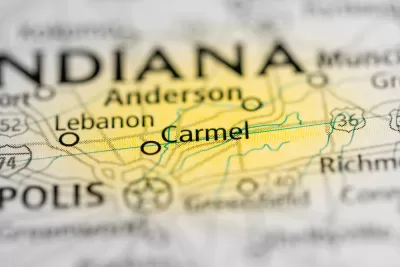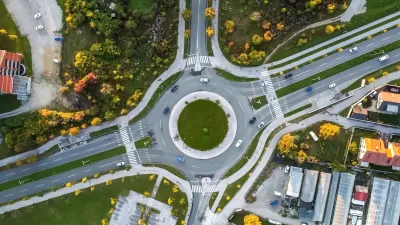Indiana's fifth-largest city, of just under 100,000, residents has 120 roundabouts, more than any city in the U.S., and only 14 traffic lights. The average traffic fatality rate is 83 percent lower than the national average.

Last May, Carmel, Indiana became one of 96 cities in the United States honored with a Silver-level Bicycle Friendly Community award from the League of American Bicyclists, a major upgrade since being awarded bronze status in 2006. Just last week, the League recognized the city with a Bronze Level Bicycle Friendly Business award.
But what makes the 47-square mile city of 92,000 residents stand out in transportation infrastructure is its use of roundabouts, not to be confused with traffic circles, in lieu of traditional traffic signals at intersections, due in large part to its longtime mayor, Jim Brainard.
"Since he took office in 1996, the city has installed more than 120 roundabouts, which Brainard said have been key in reducing traffic crashes and improving safety," reports Chris Teale for Smart Cities Dive.
Compared to national average traffic fatality rate of about 12 per 100,000 people, Carmel’s fatality rate is at two per 100,000. Brainard attributes that rate to the roundabouts having narrower lanes, forcing people to slow down. "It's all about speed," Brainard said on the sidelines of the U.S. Conference of Mayors Winter Meeting in Washington, DC. [See Jan. 22 Fox59 article and video on his participation.] He said the city now only has about 14 stoplights.
Neighboring cities have taken notice and have added roundabouts, adds Teale, "and seen similar reductions in traffic fatalities," according to Brainard. "The nicest compliment is the cities around us have copied," he said.
On the downside, there is a learning curve with roundabouts, so education plays a key role. "How to drive a roundabout" is a link on the city's Roundabouts webpage. And the state has lent a helping hand by adding two pages to its driver safety handbook. See pages 63-64 (begins on page 6 of 33) in Chapter 5: Safe Vehicle Operation [pdf]. A couple of excerpts:
A traffic circle differs from a roundabout in that it may have clockwise and counter-clockwise traffic. The approaches to the circulatory roadway of a traffic circle may also be controlled by stop signs instead of yield signs.
Some roundabouts have more than one lane, which can present a traffic hazard when smaller vehicles are driving through the roundabout alongside larger vehicles, such as tractor-trailers and buses.
On that last note, a word of caution from the Federal Highway Administration:
Multilane roundabouts tend to have higher motor vehicle speeds due to their location on multilane roads and create more conflicts between bicycles (and pedestrians) and motor vehicles. Given these higher speeds and volumes, they can present a challenge to bicyclists and may not make the corridor safer for their use.
In addition to crediting roundabouts with improvements in traffic safety, Brainard notes that due to the elimination of queuing at conventional traffic signalized intersections, the need for roadway widening is reduced.
"Many times, the engineering answer to congestion is to add lanes, and I'm convinced that all we're doing is building a bigger parking lot to get more people through the green cycle of the light when that light's green," Brainard said. "If you have constant flow through the intersection, we don't need to enlarge those lanes, we don't need to add lanes to the roadway."
More about Mayor Brainard
Finally, the mayor, a Republican, co-chairs the Conference of Mayors' Energy Independence and Climate Protection Task Force. Along with Mayor Steve Benjamin (D) of Columbia, S.C. and then-Mayor Jackie Biskupski of Salt Lake City, Utah, he participated in a Congressional hearing of the House Environment and Climate Change Subcommittee of the Energy and Commerce Committee on April 2, 2019, entitled, "Lessons from Across the Nation: State and Local Action to Combat Climate Change.” And yes, he did tout the energy and climate benefits of roundabouts in his testimony [pdf].
• Replaced traditional signalized intersections with roundabouts. Carmel now has 122 roundabouts, more than any other U.S. city – Roundabouts reduce injury accidents 80 percent, reduce fuel use and harmful emissions as the start and stop movement of traffic is all but eliminated. It is estimated that replacing stop-light intersections with 122 roundabouts saves drivers in our community about 272 tanker trucks of fuel per year, which translates into a reduction of carbon emissions by approximately 27,816 tons annually.
"Brainard was also one of four Republicans on former President Obama’s 26-member task force of state and local elected officials created to give the previous White House feedback on how local communities are dealing with climate change," noted USA TODAY in an article about U.S. mayors taking action after President Trump announced his withdrawal from the Paris climate agreement on June 1, 2017.
In his own city, Brainard has pushed various initiatives to reduce carbon emissions including purchasing hybrid and bio-fuel vehicles, planting trees and keeping traffic moving by building roundabouts instead of traffic signals.
Related in Planetizen:
-
First Roundabout Comes to New York City, August 3, 2015
-
The Rise Of the Smart Growth Suburb (about Carmel), February 24, 2015
-
Los Angeles Planning Its First Roundabout, January 19, 2014
-
Suburbs Become the New Cities (about Carmel), October 18, 2012
FULL STORY: Carmel, IN's secret to reducing traffic fatalities? Roundabouts

Planetizen Federal Action Tracker
A weekly monitor of how Trump’s orders and actions are impacting planners and planning in America.

Vehicle-related Deaths Drop 29% in Richmond, VA
The seventh year of the city's Vision Zero strategy also cut the number of people killed in alcohol-related crashes by half.

As Trump Phases Out FEMA, Is It Time to Flee the Floodplains?
With less federal funding available for disaster relief efforts, the need to relocate at-risk communities is more urgent than ever.

Texas Safety Advocates Raise Alarm in Advance of Tesla Robotaxi Launch
The company plans to deploy self-driving taxis in Austin with no oversight from state or local transportation agencies.

How to Fund SF’s Muni Without Cutting Service
Three solutions for bridging the San Francisco transit agency’s budget gap without reducing service for transit-dependent riders.

Austin Tests Self-Driving Bus
Autonomous buses could improve bus yard operations for electric fleets, according to CapMetro.
Urban Design for Planners 1: Software Tools
This six-course series explores essential urban design concepts using open source software and equips planners with the tools they need to participate fully in the urban design process.
Planning for Universal Design
Learn the tools for implementing Universal Design in planning regulations.
Borough of Carlisle
Smith Gee Studio
City of Camden Redevelopment Agency
City of Astoria
Transportation Research & Education Center (TREC) at Portland State University
City of Camden Redevelopment Agency
Municipality of Princeton (NJ)





























